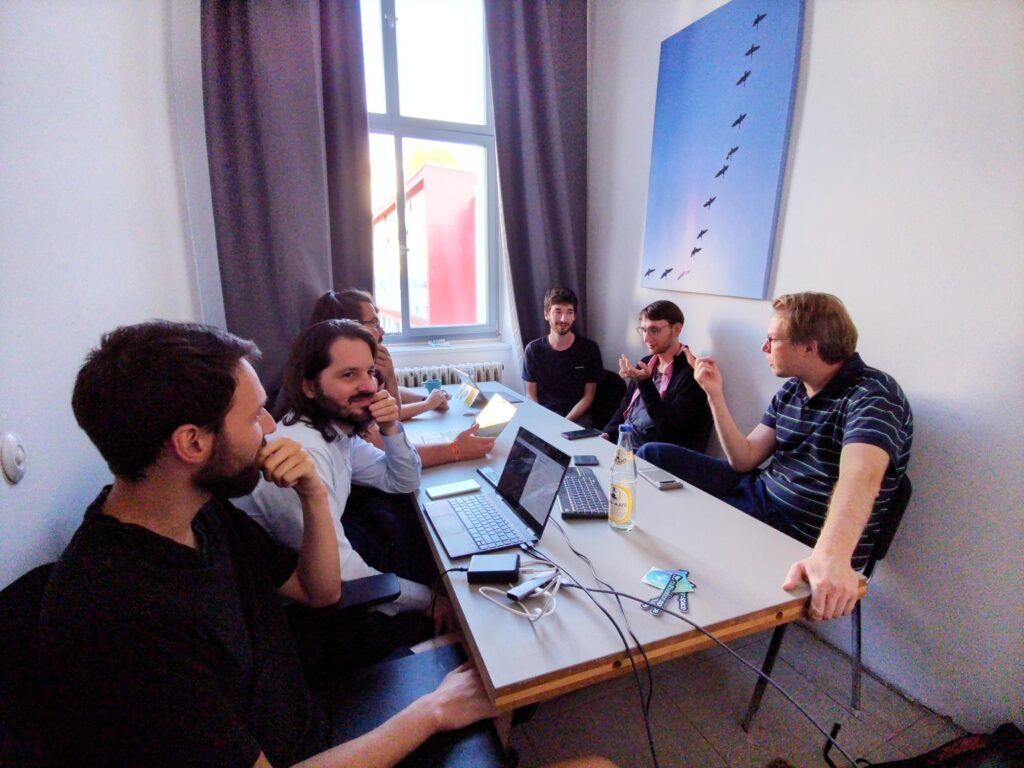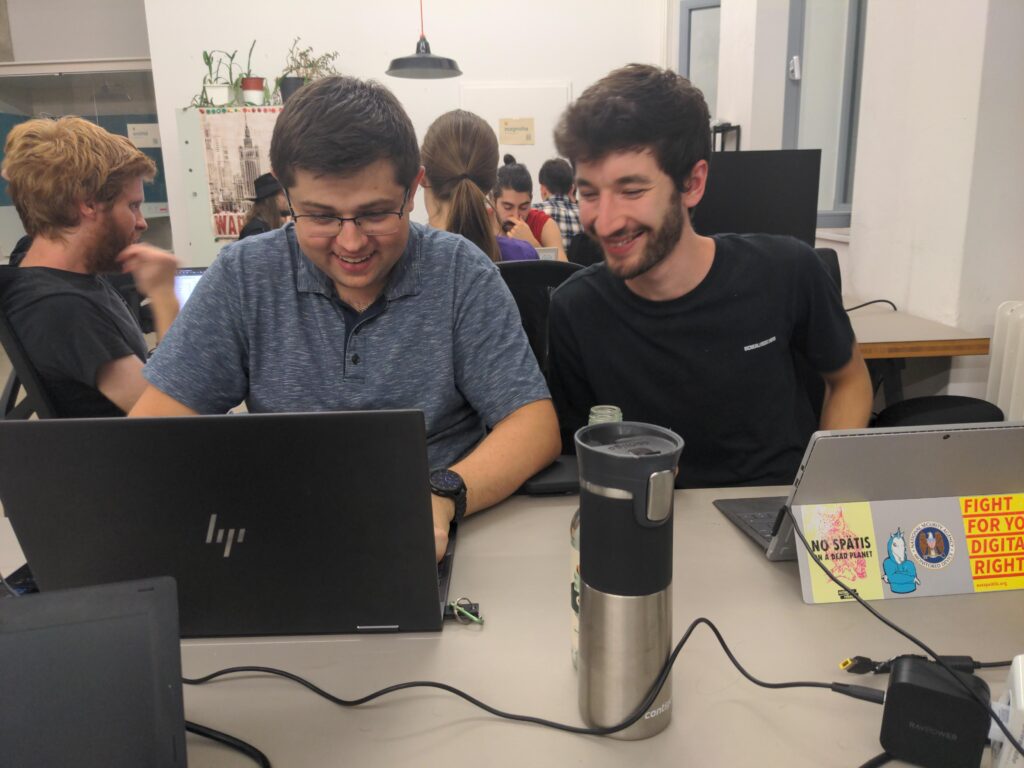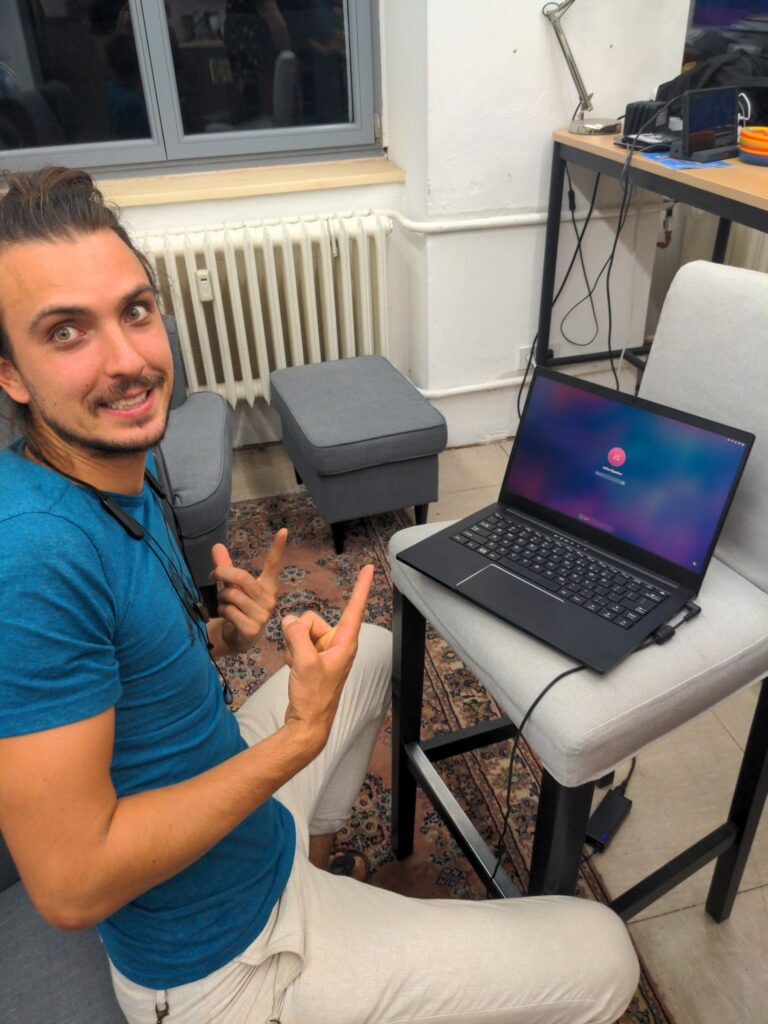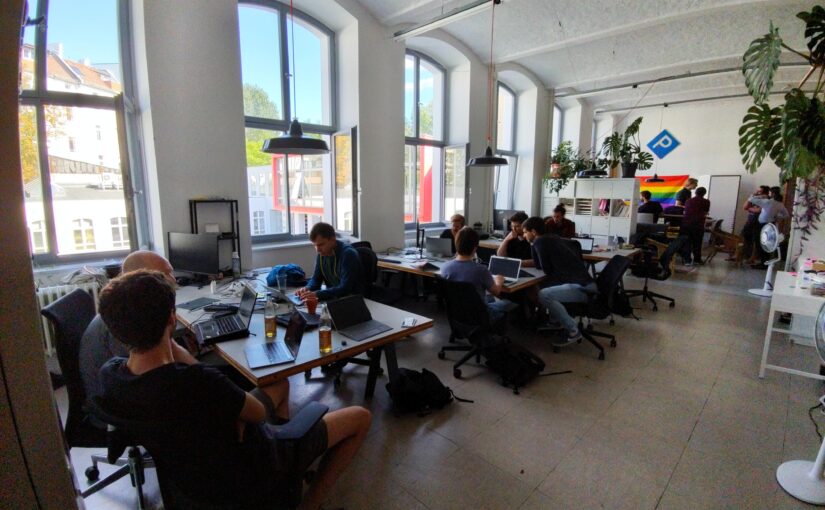In celebration of the 45 release we had a hackfest and release party in Berlin last week. It was initially supposed to be a small event, but it turns out the German community is growing more rapidly than we thought! In the end we were around 25 people, about half of them locals from Berlin :)
GNOME OS
Since many of the GNOME OS developers were in town for All Systems Go, this was one of the main topics. In addition to Valentin, Javier, and Jordan (remote), we also had Lennart from systemd and Adrian from carbonOS and discussed many of the key issues for image-based operating systems.
I was only present for part of these discussions so I’ll leave it to others to report the results in detail. It’s very exciting how things are maturing in this area though, as everyone is standardizing on systemd’s tools for image-based OSes.

Local-First
On Saturday the primary topic was local-first. This is the idea that software should always work offline, and optionally use the network when available for device sync and collaboration. This allows for people to own their data, but still have access to modern features like multiplayer editing.
People in the GNOME community have long been interested in local-first and we’ve had various discussions and experiments in this direction over the past few years. However, so far we have not really investigated how we’d implement it at a larger scale, and what concrete steps in that direction would look like.
For context, any sync system (local-first or not) needs the following things:
- Network: Device discovery, channel to send the actual data, way to handle offline nodes, encryption, device authentication, account management
- Sync: Merging data from different peers, handling conflicts
- UI: User interface for viewing and manipulating the data, showing sync status, managing devices, permissions, etc.
Local-first usually refers to systems that do the “sync” part on the client, though that doesn’t mean the other areas are easy :)
Muse
Adam Wiggins stopped by on Saturday morning to tell us about his work on Muse, a local-first whiteboard app for Apple platforms. While it’s a totally different tech stack and background, it was super interesting because Muse is one of very few consumer apps using local-first sync in production today.
Some of my takeaways from the session with Adam:
- Local-first means all the logic lives in the client. In the Muse architecture, the server is extremely simple, basically just a dumb pipe routing data between clients. While data is not encrypted end-to-end in their case, it’s possible to use this same architecture with E2E.
- CRDTs (conflict-free replicated data types) are a magical new advancement in computer science over the past few years, which makes the actual merging of content relatively easy.
- Merge conflicts are not as big a deal as one might think, and not the hardest problem to solve in this space.
- Local-first is a huge opportunity for desktop projects like GNOME. We were not really able to be competitive with proprietary software in the past decade on features like sync and multiplayer because we can’t realistically run huge cloud services for every single app/use case. Local-first could change this, since the logic is shifting back to the client. Servers become generic dumb pipes, which all kinds of apps can use without needing their own custom sync server.
To learn more about Muse, I recommend watching Adam’s Local-First Meetup talk from earlier this year, which touches on many of the topics we discussed in our hackfest session as well.
Other Relevant Art
The two projects we discussed as relevant art from our community are Christian Hergert’s Bonsai, and Carlos Garnacho’s work on RDF sync in tracker (codename “Emergence”).
Bonsai is not quite local-first architecturally, since it assumes an always-on home server. This server hosts your data and runs services, which apps on your other devices can use to access data, sync, etc. This is quite different from the dumb pipe server model discussed above, and of course comes with the usual caveats with any kind of public-facing service on local networks (NAT, weird network configurations, etc.).
Codename “Emergence” is a way to sync graph databases (such as tracker’s SPARQL database). It only touches on the “sync” layer, and is only intended for app data, e.g. bookmarks, contacts, and the like. There was a lot of discussion at the hackfest about whether the conflict resolution algorithm is/could be a CRDT, but regardless, using this system for syncing some types of content wouldn’t affect the overall architecture. We could use it for syncing e.g. bookmarks, and share the rest of the stack (e.g. network layer) with other apps not using tracker.

Next Steps
By the end of the hackfest, we had a rough consensus that long-term we probably want something like this:
- Muse-style architecture with dumb pipe sync servers that only route encrypted traffic between clients
- Some kind of system daemon that apps can use to send packets to sync servers, so they don’t all have to run in the background
- The ability to fall back to other kinds of transport with full compatibility, e.g. local network or USB keys
- A client library that makes it easy to integrate sync into apps, using well-established CRDTs
However, there was also a general feeling that we want to go slowly and explore the space before coming up with over-engineered solutions. To this end, we think the best next step is to try CRDTs in small, self-contained apps. We brainstormed a number of potentially interesting use cases, including:
- Alarms: Make extra sure you hear your alarms by having it synced on all devices
- Scratchpad: Super simple notepad that’s always in sync across devices
- Emoji history: The same recently used emoji on all devices
- Podcasts: Sync subscription list, episode playback state, per-episode progress, currently played episode, etc.
- Birthday reminders: Simple list of birthdays with reminder notifications that syncs across all devices
For a first minimum viable prototype we discussed ways to cut as many corners as possible, and came up with the following plan:
- Use an off-the shelf plain text CRDT to build a syncing scratchpad as a first experiment
- To avoid having to deal with servers, do peer-to-peer transfer only and send data via WebRTC data channel
- For peer discovery, just hardcode a public WebRTC STUN server in the client
- Simple Rust GTK app mostly consisting of a text area, using gstreamer for WebRTC and automerge for CRDTs
- Sync only between two devices
We’ll see how this develops, but it’s great to have mapped out the territory, and put together a concrete plan for next steps in this direction. I’m also conscious that we’re a huge community and only a handful of people were present at the hackfest. It’s very likely that these plans will evolve as more people get involved and we get more experience working with the technology.
For more detail on the discussions, check out the full notes from our local-first sessions.
If you’d like to experiment with this in your own app and have any questions, don’t hesitate to reach out :)

Transparent Panel
Jonas has had an open merge request for a transparent panel for a number of years, and while we’ve tried to get it over the line a few times we never quite managed. Recently Adrian Vovk was interested in giving it another try, so at the hackfest him and Jonas sat down and did some archaeology on Jonas’ old commits, rebased it, got it to work agian, and opened a new merge request.

While there are still a few open questions and edge cases, it’s early in the cycle so there’s a real chance that we might finally get this in for 46 :)
And More!
A few other things I was involved with during the hackfest:
- Julian looked into one of my pet bugs: The default generated avatars when you create a new account not looking like AdwAvatar, but using an older, uglier implementation. This is surprisingly tricky because GDM/GNOME Shell can’t show GTK widgets, and the exported PNG avatars from libadwaita can only be exported at the size they’re being displayed at (which is smaller than in GDM/GNOME Shell).
- We worked a bit on Annotations in Evince with Pablo, and also interviewed Keywan about how they use annotations in the editorial process for their magazine.
- DieBahn was officially renamed to Railway, and we discussed next steps for the app and train APIs in general. Railway works for so many providers by accident, because so many of them use the same backend (HAFAS), but it’d be great to have actual open APIs for querying trains from all providers. Perhaps we need a lobbying group to get some EU legislation for this? :)
- We discussed a “demo mode”, i.e. an easy way to set up a device with a bunch of nice-looking apps, pre-loaded with nice-looking content. One potential approach we discussed was a script that installs a set of apps, and sets them up with data by pre-filling their
.var/app/directories. The exact process for creating and updating this data would need looking into, but I’m very interested in getting something set up for this, because not having it really our software hard to demo. - Marvin showed me how he uses CLion for C/Vala development, and we discussed what features Builder would need to gain for him to switch from his custom Vala setup in CLion to Builder.

Thanks to Sonny for co-organizing, Cultivation Space for hosting us, and the GNOME Foundation for financial sponsorship! See you next time :)


Interesting blog!
For “demo mode” you may want to think bigger – it can be implemented as a form of remote account synchronisation.
You have a central account somwhere (google, Nextcloud, somewhere else that gives such sync feaures) and then when creating a new user, it should ask for account sync credentials and load them.
As a demo account you can have them sync from a gnome nextcloud server, but end users get to choose their own infrastructure to sync with.
(I am guessing I am missing out all the complexities from that model which has prevented this from existing for the last 10 years… but the idea is exciting)